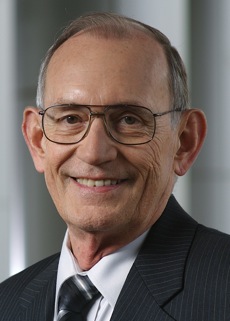Peercy, longtime UW–Madison engineering dean, to retire
In 1999, first-year dean of the University of Wisconsin–Madison College of Engineering Paul Peercy looked around at the other new kids — the undergraduate students — and wondered why more than half of them were not persisting into their second year as engineering majors.

Peercy
Peercy instituted tutoring to get freshmen through their first college-level math and science classes, and spurred the inclusion of engineering courses in the first-year curriculum to address the issue. As student retention rose, Peercy led by example, becoming one of the longest-serving deans on campus.
After nearly 13 years as dean, Peercy today (Wednesday, Feb. 8) announced plans retire.
“Under Paul’s leadership, the College of Engineering has achieved new heights of success in a broad range of areas. These cover the full engineering spectrum, but most importantly partner engineering with a new range of science endeavors,” says Paul M. DeLuca Jr., UW–Madison provost. “These efforts resulted in numerous educational and funding opportunities for faculty and staff and areas of discovery for students.”
The university will soon begin an international search for a new engineering dean, and Peercy has offered to stay on until that process is complete.
Peercy made physics his college major — eventually earning a doctorate in physics from UW–Madison in 1966 — in some part because the engineering training of the day didn’t interest him.
“When I went to school, engineering was a practicum,” says Peercy, a fellow of the American Association for the Advancement of Science, the American Physical Society and the Institute of Electrical and Electronics Engineers. “It wasn’t science-based.”
That has changed.
“Back then, if you wanted to build something you went to handbooks of properties of materials and looked at the tables to see what the material could withstand,” Peercy says. “Today, if you want to build something, you turn to the periodic table and say, ‘What properties do I need for the materials in this high-performance system?'”
“We’re trying to educate engineers that are globally competent and locally relevant. A bridge has to do the same thing no matter where it is: it has to stand up. But to engineer something that works locally, a bridge in Madison will be much different than a bridge in Beijing.”
Paul Peercy
High-performance systems are nothing new to Peercy, a member of the National Academy of Engineering. He followed a postdoctoral appointment at Bell Laboratories with 27 years at Sandia National Laboratories in New Mexico — rising from the technical staff to director of microelectronics and photonics, guiding semiconductor development at three national labs.
Peercy spent the latter half of the 1990s as president of SEMI/SEMATECH, a consortium, steering technical issues for the nation’s top suppliers to the semiconductor industry, helping U.S. companies build up to serving three-quarters of the world’s semiconductor needs.
When Peercy came to UW–Madison, he applied the same approaches he used in scientific and professional organizations leadership roles on campus and in the broader field of engineering education.
“Paul has been an outstanding colleague to fellow deans and to senior administration,” DeLuca says. “He always volunteers for the difficult tasks and brings a vibrant perspective that reflects a broad institutional commitment.”
He has served on the executive committee and as chairman of the Engineering Deans Council for the American Society for Engineering Education and in similar roles for the Global Engineering Council, leading discussion on the kind of engineering education that will address the major challenges facing the country and the planet.
As engineering at UW–Madison has subdivided into 14 undergraduate degrees (and 22 at the graduate level), the boundaries between engineering disciplines and the physical, biological and health sciences departments on campus have quickly disappeared, according to Peercy. Many members of the engineering faculty also have one foot in the medical school or departments like computer sciences and chemistry.
“We’re increasing our students’ exposure to core science and technology in these disciplines,” Peercy says. “But along with that, we’re broadening their interdisciplinary experience so they can, among other things, communicate within the interdisciplinary teams they’re likely to end up working in.”
Those teams are vital to solving the big challenges facing the human race — such as energy needs, pollution and the logistical problems presented by megacities.
“Engineering is where science meets society,” Peercy says. “These are problems that can’t be solved without engineers and can’t be solved by engineers alone.”
These problems appear different through differing cultural frames of reference. As part of Peercy’s “Engineering Beyond Boundaries” vision for the college, students are encouraged like never before to seek out international experiences before becoming practicing engineers.
“We’re trying to educate engineers that are globally competent and locally relevant,” Peercy says. “A bridge has to do the same thing no matter where it is: it has to stand up. But to engineer something that works locally, a bridge in Madison will be much different than a bridge in Beijing.”
The bridge to engineering’s future will look different than its present, but Peercy says UW–Madison’s College of Engineering is pointed in the right direction.
“We’ve drilled down to the scientific bedrock in each discipline, and in each case came to common bedrock that determines knowledge and concepts our students need to learn,” he says. “The last century was about disintegration. This century will be about integration. It’s a tribute to the quality of this university and its culture that we support the sort of collaborative work and cross-disciplinary thinking our graduates will need.”
Enjoy this story?
Read more news from the College of EngineeringTags: College of Engineering
